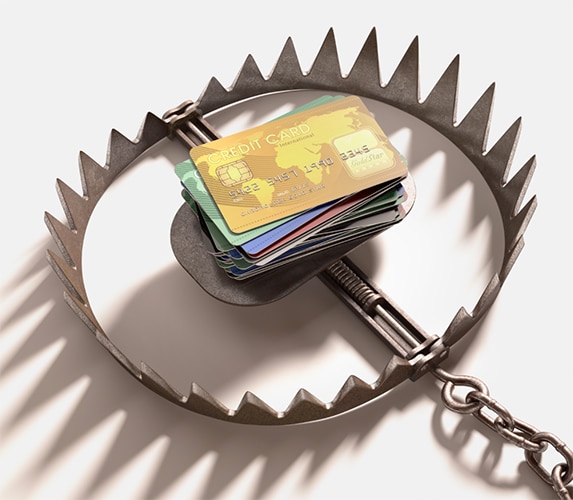- HOME
- /
- Better Living
- /
- Money
- /
A Beginner's Guide To Borrowing
Taking a loan isn't ideal. How to do it if you must

The secret to financial bliss is limiting our borrowings and fulfilling our needs and responsibilities within our means. Consider a home loan or borrowing for sudden medical expenses versus using a credit card to pay off a shopping binge. The first two are 'good' debts as they help secure our future. The last one is a 'bad' debt because it eats into our unearned future income. Smart borrowers avoid such debt. Here's everything you need to know before you decide to take a loan.
Different ways to borrow
Borrowings could be either in the form of a loan or an overdraft. In case of a loan, interest is charged on the total amount borrowed for a specific time period. If we have borrowed Rs 25,000 for one year, interest is charged on the entire amount for the whole year.
Borrowing on a credit card is an overdraft. Suppose our credit card statement reflects a total spending of Rs 25,000. We decide to pay Rs 10,000 immediately and the balance later. The credit card company will charge an interest only on the remaining sum until the entire amount is paid off. Meanwhile, the interest for any other purchases during this period will get added to the pending interest. Therefore, in an overdraft the interest is charged on the outstanding balance for the number of days you take to pay off the money.
While borrowing, clarity on whether it is a loan, an overdraft or a hybrid product (such as home loans that are a combination of a loan and an overdraft) is essential.
Is your loan secured or unsecured?
Before taking a loan, always inquire if it is secured or not. Secured loans are backed by some kind of an asset, such as a home loan, which has our home as security. In case we default, the lender can take possession of this asset. A car loan or a gold loan are other examples of secured loans.
On the other hand, personal loans are not backed by any asset and are considered unsecured loans. In case of a default, the lender does not have any recourse to assets, but can take the legal route to recover the money.
What security can you pledge?
Mortgage Different kinds of borrowings for purchasing real estate (immovable property) are called mortgage. For example: we can take a home loan, live in that house and repay the amount over a long period of time. Only when we have repaid the entire amount does the lender hand over the original documents for the property.
Hypothecation In this case, the asset (movable property) stays in our possession. When we take a car loan, the car stays with us. We can use it but cannot sell it until we have paid off the full amount.
Pledging Here, the asset is with the lender. For instance, in the case of a gold loan, the gold is in possession of the lender until the full amount is paid back.
Do you know the nature of your interest?
Most loans have a fixed rate of interest. When we take a car loan, we are quoted a rate of interest on the loan amount. Based on that rate of interest, monthly instalments, technically known as equated monthly instalments (EMIs), are decided. The rate of interest and EMI remain constant throughout the tenure of the loan. Usually, the rate of interest is fixed for a shorter duration.
For long-term borrowings such as a home loan, the rate of interest could be floating. It can be modified by the lender and can increase or decrease. We also have two-in-one home loans (a hybrid product) where a portion of the interest is fixed and the other is partly floating.
If the rate of interest is floating, a borrower should find out how often it can be changed. Reserve Bank of India has made it compulsory for all banks to link their home loan rate to a certain benchmark (for example, MCLR or marginal cost of funds based lending rate). The lender cannot randomly change the rate of interest -- they must be upfront and inform the borrower. Also, it has to be in conjunction with the set benchmark.
Are there any hidden charges?
Before borrowing, make sure you find out if other charges could apply. "We do not levy any service charge," said a telemarketer when I got a call from a bank selling a car loan. Since I am from the field of finance, I asked, "Are there any administrative or set-up charges, processing fees or any other amount that I need to pay?" Pat came a list of additional charges that were not mentioned at first. Be careful of those 'hidden' charges, over and above the rate of interest.
Prepayment
During the repayment tenure we may have access to surplus funds (from increased income, the maturity of a bond or fixed deposit, rent/ dividend/interest received from our investments, and so on) and want to repay the full amount or pay it back partially. At the outset, ask the lender if there is an option to prepay and details of the terms and conditions involved.
For certain borrowings (like a car loan) there is a lock-in period when you can't repay the loan. There may be a charge levied by the lender for prepayment. For a home loan, there is no such charge, unless one is shifting the loan to another lender (a bank or non-banking financial company).
Well-planned borrowings go a long way in supporting our wealth creation, but remember that borrowing leads to the erosion of our income. This is why smart borrowers prioritize repayment of their debt.
Gaurav Mashruwala is a financial planner and author of Yogic Wealth: The Wealth That Gives Bliss.






